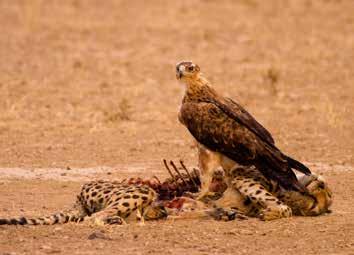
4 minute read
PHOTOGRAPHY ADVICE
18 PHOTOGRAPHY ADVICE AND TIPS - By: Dr Landi Lombard FOR BIRDLIFE IN THE KGALAGADI
Kgalagadi Transfrontier park is a magical place, in the most northern tip of the Northern Cape, with about two thirds in Botswana. It is one of my favourite places to unwind and focus on my photography. It’s an arid land with great wildlife and bird life photography opportunities, especially for birds of prey. It is massive (38000 square km), bigger than the size of Belgium. It’s possible to get close to the animals and get great photo’s, with a great dune or desert background, including birds in flight. A lot of summer bird visitors make this time of the year even more spectacular for bird photography, if you can bare
Advertisement
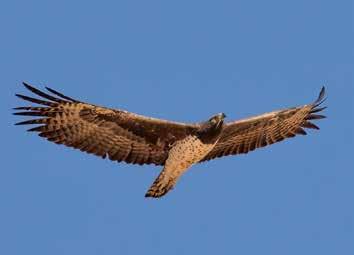
Martial Eagle (Breëkoparend) in Kgalagadi: Canon 7D Mark II, ISO 320, 400mm, shutter 1/2000, f6,3
changing all the time. You often have to work hard for sightings, which makes it even more rewarding when you get that perfect wildlife photo. For good bird photography you would need a good quality camera like a Canon or Nikon DSLR, with fast frames per second rate (preferably 8+/second) and a fast memory card. A good zoom lens is essential, preferably 300mm or more, f-stop as low as possible, preferably f4 or less. Make sure you have more than one battery and a memory card. A good bean bag to rest and stabilize your camera also helps a lot. Recently mirror-less camera entered the market and are selling well now, but I’m still committed to my DSLR camera.
Rock Kestrel (Kransvalk) in Kgalagadi: Canon 7D Mark II, ISO 400, 400mm, shutter 1/2000, f6,3
the heat. In summer, daytime temperatures often reach 45-48 degrees. The nights are fairly warm and comfortable. Only early morning drives are viable as the rest of the day is too hot. This park changes several times in the year and although it is dry and desert-like most of the year it actually often gets fairly good summer rainfall, transforming the park into a stunning green place, but makes animal spotting a lot more difficult because of the extra vegetation. The park is unpredictable with
animals moving large distances for food and water,
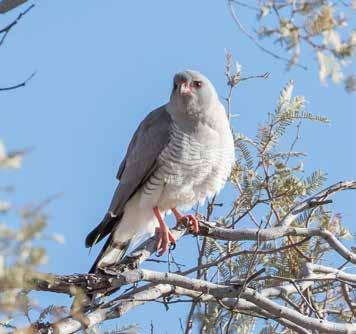
Gabar goshawk (Witkruissperwer/Klein Singvalk) in Kgalagadi: Canon 7D Mark II, ISO 640, 371mm, shutter 1/2000, f6,3
choose many modes. It’s important to work through your menus on the camera before starting. I prefer manual with auto-ISO, or you can use full manual if you’re very experienced. Other options that work well is aperture priority shooting (Av) and shutter priority (Tv) is also a good option. For birds, especially birds in flight, you need a fast shutter speed to prevent blurry photo’s, at least 2000th of a second, but faster is better. This can only be used if light allows this, which is seldom a problem in the Kgalagadi, except for early morning or late afternoon. You can get away with faster shutter speed at high ISO’s, but I want to warn you against using ISO’s above 1/2000, as this gives significant background noise on your photos when
Bateleur (Berghaan) in Kgalagadi: Canon 7D Mark II, ISO 320, 484mm, shutter 1/2500, f6,3
I have included some examples of photo’s taken in Kgalagadi, with the settings used. Always take a lot of photos of a subject to make sure you have at least a few good shots. If the bird is sitting in a beautiful tree or setting, always take a few photos with limited zoom to show the environment as well. You can always crop it later to some extent, but it is difficult to create a good background. Bird photography gives you many additional options when you’re in the field, rather than always searching for the big five. It is also very satisfying, especially birds in flight, because it’s not so easy getting everything perfect, so when you do, it’s great.
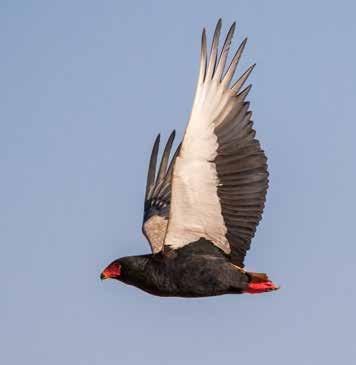
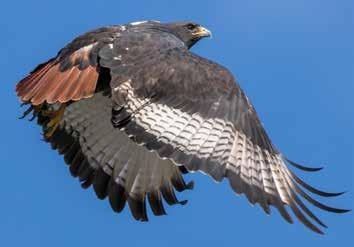
RJackal Buzzard (Rooiborsjakkalsvoel) in Kgalagadi: Canon 7D Mark II, ISO 640, 400mm, shutter 1/2500, f7,1. Lucky to get this one soon after take-off. Patience is very important as birds in flight are easier to photograph soon after take-off. Sit still and wait for the bird to take-off and be ready.
you want to crop or enlarge it. High end cameras, with full-sized sensors, deal much better with high ISO’s than more affordable options. Assess you target and the speed of movement and set your shutter speed accordingly. Birds in flight probably need more than 1/1500. Experience and practice helps a lot. Consider practicing close to home on local birds to get the ideal setting for your camera so that you don’t have to struggle with setup while photographing great subjects. If you have a smaller bird perched on a dry branch, it’s good to use low f-stops to blur the background as this will accentuate the bird. For bigger birds, too low a f-stop will sometimes mean that some parts
of the bird will be out of focus.
